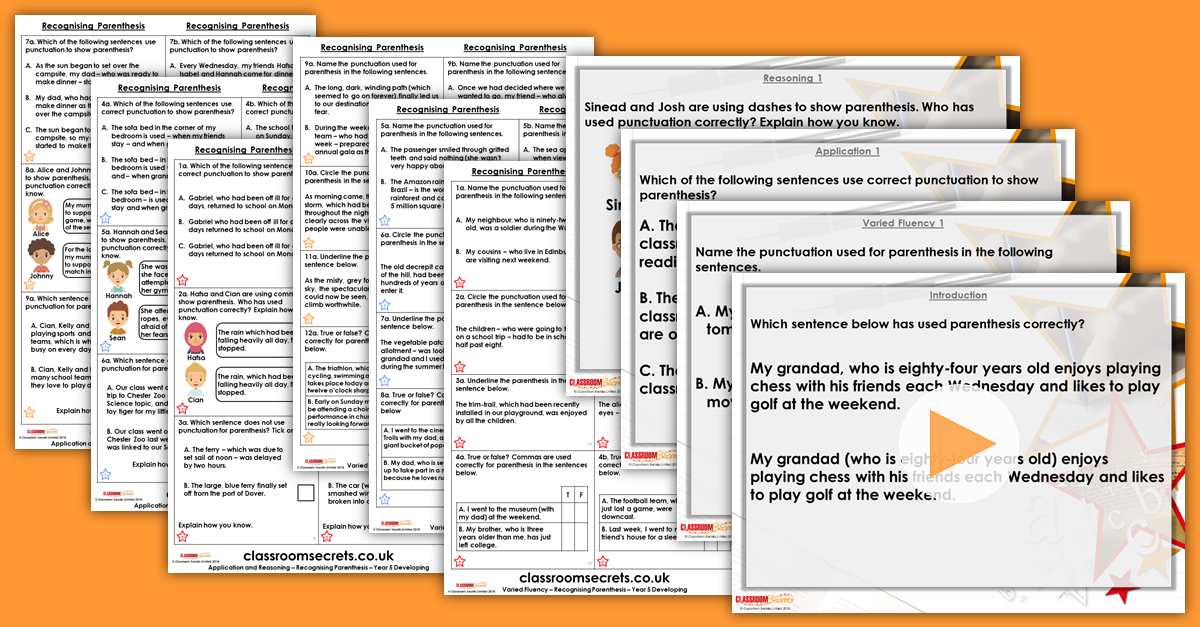Recognising Parenthesis Year 5 Parenthesis Free Resource Pack

Step 1: Recognising Parenthesis Year 5 Spring 1 Resources
Recognising Parenthesis Year 5 Resource Pack includes a teaching PowerPoint and differentiated varied fluency and application and reasoning resources. This pack is designed to work alongside our GPS Scheme of Work for Spring Block 1.
What's included in the pack?
This pack includes:
- Recognising Parenthesis Year 5 Teaching PowerPoint.
- Recognising Parenthesis Year 5 Varied Fluency with answers.
- Recognising Parenthesis Year 5 Application and Reasoning with answers.
National Curriculum Objectives
English Year 5: (5G5.9) Using brackets, dashes or commas to indicate parenthesis
Terminology for pupils:
- English Year 5: (5G5.9) parenthesis
- English Year 5: (5G5.9) bracket
- English Year 5: (5G5.9) dash
Differentiation:
Varied Fluency
Developing Questions to support recognising parenthesis located mid-sentence with two punctuation marks to demarcate it. Sentences are single clauses with added parenthesis.
Expected Questions to support recognising parenthesis located mid-sentence or at the end of the sentence. Sentences are multi-clause sentences with added parenthesis.
Greater Depth Questions to support recognising parenthesis located mid-sentence or at the end of the sentence. Sentences are multi-clause sentences with added parenthesis. Commas are also used for lists and adverbials within sentences.
Application and Reasoning
Questions 1, 4 and 7 (Application)
Developing Recognise where sentences have used punctuation for parenthesis when located mid-sentence with two punctuation marks to demarcate it. Sentences are single clauses with added parenthesis.
Expected Recognise where sentences have used punctuation for parenthesis when located mid-sentence or at the end of the sentence. Sentences are multi-clause sentences with added parenthesis.
Greater Depth Recognise where sentences have used punctuation for parenthesis when located mid-sentence or at the end of the sentence. Sentences are multi-clause sentences with added parenthesis. Commas are also used for adverbials within sentences.
Questions 2, 5 and 8 (Reasoning)
Developing Decide which sentence has used punctuation correctly when parenthesis is located mid-sentence with two punctuation marks to demarcate it. Sentences are single clauses with added parenthesis.
Expected Decide which sentence has used punctuation correctly when parenthesis is located mid-sentence or at the end of the sentence. Sentences are multi-clause sentences with added parenthesis.
Greater Depth Decide which sentence has used punctuation correctly s located mid-sentence or at the end of the sentence. Sentences are multi-clause sentences with added parenthesis. Commas are also used for lists and adverbials within sentences.
Questions 3, 6 and 9 (Reasoning)
Developing Identify sentences not using punctuation for parenthesis when parenthesis is located mid-sentence with two punctuation marks to demarcate it. Sentences are single clauses with added parenthesis.
Expected Identify sentences not using punctuation for parenthesis when parenthesis is located mid-sentence or at the end of the sentence. Sentences are multi-clause sentences with added parenthesis.
Greater Depth Identify sentences not using punctuation for parenthesis when parenthesis is located mid-sentence or at the end of the sentence. Sentences are multi-clause sentences with added parenthesis. Commas are also used for lists and adverbials within sentences.
This resource is available to download with a Taster subscription.





